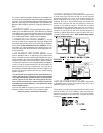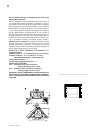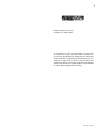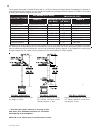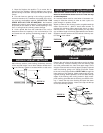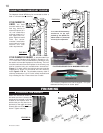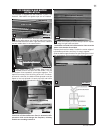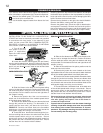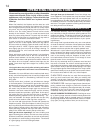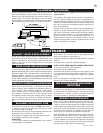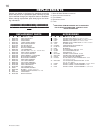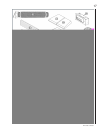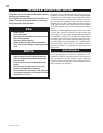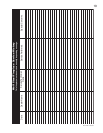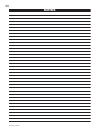
W415-0156 / A / 04.09.03
14
For maximum efficiency, when the fireplace is thoroughly
hot, load it fully to the top of the door opening and burn at a
medium low setting. The bricks will be nearly all white and
the glass mostly clear. The whiteness of the bricks and the
cleanness of the glass are good indicators of your operat-
ing efficiency.
Not enough heat is produced when only one or two pieces
of wood are burned. A minimum of three pieces are needed
to encase a bed of coals that sustains the fire. Loosely
stacked wood burns quicker than a tightly packed load.
Wood burns in cycles rather than giving a steady output of
heat. It is best to plan these cycles around your household
routine so that only enough coals are left to start the next
load. In the evening, load your fireplace, at least, a half-
hour before bed to ensure the fire is hot enough to close
the draft control for an overnight burn.
Burn only dry seasoned wood. It produces more heat and
less soot or creosote. Do not burn ocean beach wood. Its
salt content can produce a metal eating acid. When refueling
open the door slowly to prevent smoke spillage. Use a pair
of long fireplace gloves when feeding the fire. Keep a small
steel shovel nearby to use as a poker and to remove ashes.
Do not store wood within 3 feet (1m) of the fireplace.
FLASH FIRES: A flash fire is a small fire burned quickly
when you don't need much heat. After your kindling has
"caught", load at least 3 pieces of wood, stacked loosely.
Burn with the draft control fully open or closed only slightly.
EXTENDED FIRE: Load your larger pieces of wood com-
pactly, packed close enough to prevent the flames from
penetrating it completely. After approximately 30 minutes,
depending on the size of the load, close the draft control
completely making sure that the fire is not extinguished.
DO NOT OVERFIRE THE FIREPLACE! Overfiring can occur
by: a) burning large amounts of smaller wood pieces such
as furniture scraps, skids or treated wood; b) vigorously
burning large loads of wood with the draft control on "HIGH"
(fully open) for long periods of time (one or two hours).
FUEL LOADING AND BURN CYCLE
Remove all source of gasoline or other flammable
vapours and liquids in the vicinity of this or other
appliances prior to lighting. Ensure that the top
firebricks and fibre baffles are in place and not
lifted up.
When first installed, the fireplace and the steel are cold
and must become hot before the fireplace will function
well. During the break-in period (the first 2 or 3 fires) create
only small, hot fires using kindling; this will allow the fire-
brick to cure. Do not be alarmed if small hairline cracks
develop in the firebrick. This is a normal occurrence and
does not pose a safety hazard. The paint may also smell a
little for the first few fires as it cures and you may wish to
open a door or window to alleviate the smell.
To start, a brisk fire is required. Place loosely crumpled
paper on the floor of the fireplace behind the log retainer
and cover with dry kindling. Open the draft control fully by
moving the lever to "HIGH". Light the paper and leave the
door slightly ajar (one inch) until all kindling is burning. To
maintain a brisk fire, a hot coal bed must be established
and maintained.
Slowly add larger wood (2x4 size pieces). Lay the pieces
lengthwise from side to side in the hot coal bed with a
shallow trench between, so that the primary air can flow
directly into this trench and ignite the fuel above. When the
fire seems to be at its peak, medium sized logs may be
added. Once these logs have caught fire, carefully close
the door.
Closing the door too quickly after refueling will reduce
the firebox temperature and result in an unsatisfactory
burn.
Remember it is more efficient to burn medium sized wood,
briskly, and refuel frequently than to load the fireplace with
large logs that result in a smouldering, inefficient fire and
dirty glass.
As soon as the door is closed, you will observe a change
in the flame pattern. The flames will get smaller and lazier
because less oxygen is getting into the combustion cham-
ber. The flames, however, are more efficient. The flames
will remain lazy but become larger again as soon as the
firebricks have been heated thoroughly and the chimney
becomes heated and provides a good draft. At this point,
the roaring fire that you see when the door is opened is
wastefully drawing heated room air up the chimney -- cer-
tainly not desirable. So always operate with the door fully
closed once the medium sized logs have caught fire.
You can now add larger pieces of wood and operate the
fireplace normally. Once the fireplace is entirely hot, it will
burn very efficiently with little smoke from the chimney. There
will be a bed of orange coals in the firebox and secondary
flames flickering just below the top of the firebox. You can
safely fill the firebox with wood to the top of the door.
Can't get the stove operating? Use more kindling and
paper. Assuming the chimney and vent are sized correctly
and there is sufficient combustion air, the lack of sufficiently
dry quantities of small kindling is the problem. Thumb size
is a good gauge for small kindling diameter.
OPERATING INSTRUCTIONS
Can't get heat out of the stove? One of two things may
have happened. The fireplace door may have been closed
prematurely and the fireplace itself has not reached opti-
mum temperature. Re-open the door and/or draft control to
re-establish a brisk fire. The other problem may have been
wet wood. The typical symptom is sizzling wood and mois-
ture being driven from the wood.



